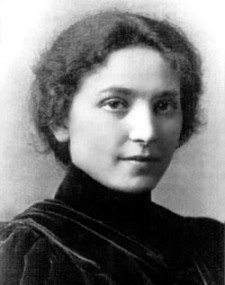by Miyu Suzuki
Women’s athletic activity was not common in the nineteenth century. Women could not play team sports of any kind. In school education in particular, there was a large difference between women and men. Senda Berenson Abbott, who was the first director of physical education at Smith College, had some doubts about inequality. She was interested in basketball, which was invented by James Naismith at the same time, and introduced it to her students. She believed that playing basketball would be at the forefront of the women’s athletic activity and women’s athletic activity would be beneficial for females. However, the rules made by James Naismith were for men and they were not considered to be suitable for women. Therefore, Berenson modified the rules considering the expectations of the Victorian Era. The rules modified by Berenson influenced women’s physical education and adhered to the social expectations of women in the Victorian Era.
Senda Berenson Abbott, born in Butrimonys, Vilnius gubernia, Russian Empire in 1868, is known as “the mother of women’s basketball†and influenced today’s school physical education and women’s behavior. When she was seven years old, her family immigrated to America, and she spent her life in America until she died. She preferred art, literature and the piano to sports as a child. “However, back problems forced Berenson to give up the piano and in 1890 she decided to enter the Boston Normal School of Gymnastics.â€Â As her back improved, she came to like gymnastics more. In 1892, a physical education program was established at Smith College, and she was recommended for this job. She remained there for 19 years. She read a story in the January 1892 edition of the YMCA college newspaper, The Triangle about men’s basketball. In 1891, the game of basketball was invented by James Naismith. Many people were interested in basketball. Berenson thought that basketball could be adapted for female students. Then, Berenson organized the first women’s collegiate basketball game in 1893. She made use of this experience and modified the rules. The rules she made for women’s basketball were approved by the American Association for the Advancement of Physical Education and were in play until the 1960’s. Also, she organized the Basketball Committee for women in 1905. This committee later became known as the National Association for Girls and Women in Sport.  In 1911, she married an English professor Herbert Vaughan Abbott. Soon she left her position at Smith. After retirement from education, she devoted her life to the study of art and music. Berenson is not only the founder of women’s basketball but also an influential person for women’s sports activity.
The rules modified by Senda Berenson influenced physical education. Sports and gymnastics had been recognized as physical education for men for many years before the 1890’s because sports were associated with military training. Women didn’t play team sports of any kind. Berenson believed that women should be more active and play team sports, too. She took notice of basketball and modified the rules for her students. For example, she suggested “Divide the court into three equal areas,†“No stealing the ball†and “No holding the ball for more than three seconds.†It is obvious from these rules that Berenson modified the rules because she considered that there were differences between women and men in physical strength and build. She introduced the rules for women in 1892, at the same time that the Journal of Physical Education (a publication of YMCA) devoted an issue to women and stated that “women needed physical strength and endurance.†Berenson made sure that the importance of sports for women was recognized and adapted it to women’s physical strength and build, therefore the original form of today’s women’s physical education was formed.
The rules modified by Senda Berenson adhered to the social expectations of women in the Victorian Era. Berenson believed that basketball could decrease the stress of her students. Therefore, she introduced basketball for her students and modified the rules to suit women. Her concern about the rules were not only the physical activity of women but also the standards of behavior for young women in the late Victorian Era.  For example, “Dribbling was forbidden in women’s basketball. On the other hand, men were allowed to dribble. The women’s rule committee thought dribbling would be unladylike.  Because of these strict rules, strong female players were not born. The rule system also included clothing. The women players had to wear bloomers, blouses and thick stockings. Fashionable clothes were regarded as more important. These rules considered appearance above comfort. At that time some people agreed with women’s athletic activity, others thought exercise was not socially acceptable for women. Society also believed that women should be quiet, gentle and ladylike. That’s why ladylike behavior was so important for women’s rules.  Berenson’s wish was to promote basketball and sports for women. So, she modified the rules while considering the social restrictions and needs of the late Victorian Era.
Senda Berenson Abbott modified the rules to give women the opportunity to play sports in physical education, which was very hard task for her because she had to consider the social expectations for women. After she modified the rules, some educators, physicians, and members of the general public thought that women’s sports should be reconsidered. They felt women’s sports were becoming too competitive, which they considered unladylike. Berenson was the first to work with the promotion of women’s physical activity, therefore many people came to think about it. The rules modified by Senda Berenson Abbott aren’t used now, but she contributed greatly to women’s basketball helped give women the freedom to play sports.
Suggested Reading
Steen, Sandra, and Susan Steen. Taking it to the Hoop: 100 Years of Women’s Basketball. Connecticut: Twenty-First Century Books, 2003.
Miyu Suzuki is a second-year student in the Department of British and American Cultural Studies.

